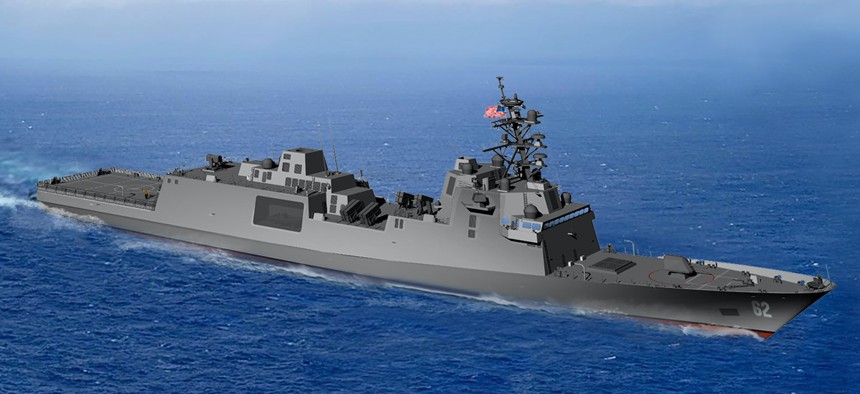
Rendition of U.S. Navy FFG(X) frigate Fincantieri
To Compete With Russia and China at Sea, Think Small
Great power competition requires more than preparing for great power conflict.
No other navy comes close to the sheer number of aircraft carriers, cruisers, and destroyers in the U.S. fleet, but when it comes to smaller vessels like frigates and corvettes, the United States is far outnumbered by China and Russia. And being top-heavy is not good for stability in today’s power dynamics.
For the last few years, the U.S. Navy has been engaged in great power competition, ostensibly on many levels. At one end of the spectrum, this means deterring conflict with China and Russia and — if that fails — fighting to win. The U.S. fleet is built and deployed with that high-end mission in mind. But at the other end, the great powers are competing day-to-day for global influence. This requires a subtler battle over partners and messages. To win this day-to-day competition, the Navy will need a dispersed force of smaller, less expensive vessels.
The 10 new FFG(X) frigates, awarded April 30, will partially help when they arrive. In the meantime, the competition is taking advantage of the Navy’s absence. A Russian frigate called at Caribbean ports last year as Moscow expanded its support to Venezuela through an agreement for naval visits. China uses small naval deployments in Asia and East Africa to support an expansive vision of its Belt and Road Initiative. And the Russian and Chinese navies together joined in a week of exercises with South Africa last year.
By contrast, no U.S. Navy vessel had circumnavigated Africa for nearly a decade until the destroyer Carney did so earlier this year while transiting between fleets. It made just one stop on the continent. The latest ship to deploy to Africa Partnership Station, the Navy’s “flagship maritime security cooperation program” in Africa, was a lone transport ship.
If the Navy is serious about competing day-to-day with China and Russia, it needs to affirm a strategy that doing the little things is important. This must influence where the Navy goes, what it does, and what it buys. One new frigate won’t solve the problem, but it could be a start.
Day-to-day competition is a natural role for the Navy. When the Army arrives on foreign soil, it’s an invasion. But a ship parked offshore can provide calibrated reassurance or deterrence. The Navy doesn’t needs boots on the ground to support other countries’ efforts to fight piracy, resource predation, foreign interference or terrorism.
The current fleet is ill-suited to this constellation of low-end missions for three reasons. First, those missions could distract crews on the most lethal warships from preparing for high-end conflict, so the Navy is unlikely to prioritize them. Second, large ships are often the wrong tools for such missions, being a poor match for training with allied navies equipped with nothing larger than frigates or corvettes. Third, the current fleet deploys to deter conflicts in potential hotspots, such as the South China Sea or High North. When the Navy is needed for smaller tasks in lower-risk parts of the world, its ships are too far away to get involved.
With less sophisticated platforms, however, the Navy could engage in cost-effective competition in less-risky neighborhoods. To date, the Navy has not shown much interest in building these ships. Apart from some specialized craft, the U.S. fleet has no major class of warship between the 77-ton Mark VI patrol boat and the 3,200-ton littoral combat ship. The new frigate is a step in the right direction. But at $800 million, heavier than nearly any other frigate, and equipped with advanced Aegis air defenses, it’s not built for cultivating relationships in the Caribbean or the Gulf of Guinea.
The U.S. Coast Guard does have well over a hundred cutters that would fit into this gap in the Navy fleet. And the Coast Guard’s occasional humanitarian relief efforts and training in other countries do help the U.S. compete day-to-day. But the Coast Guard is small, and the presence of a Navy “gray hull” sends a more powerful signal.
With an adequate supply of smaller ships, the Navy could disperse the force to ensure that competition is as global as U.S. strategy claims it should be. Lower-risk regions would not need a robust fleet. The Navy could even resurrect the 19th-century practice of foreign stations— scattered homeports anchored by a station ship and supported by a small squadron. Such a presence would signal an enduring U.S. commitment to regional allies and partners. The station commodore would have the time in-country to build relationships and trust.
None of this will happen if great power competition remains merely a talking point, while the actual motivating force in the Navy is great power conflict. The United States needs a Navy that is not just ready to win the war we all hope will never come, but also prepared to win the competition for influence already taking place every day.



